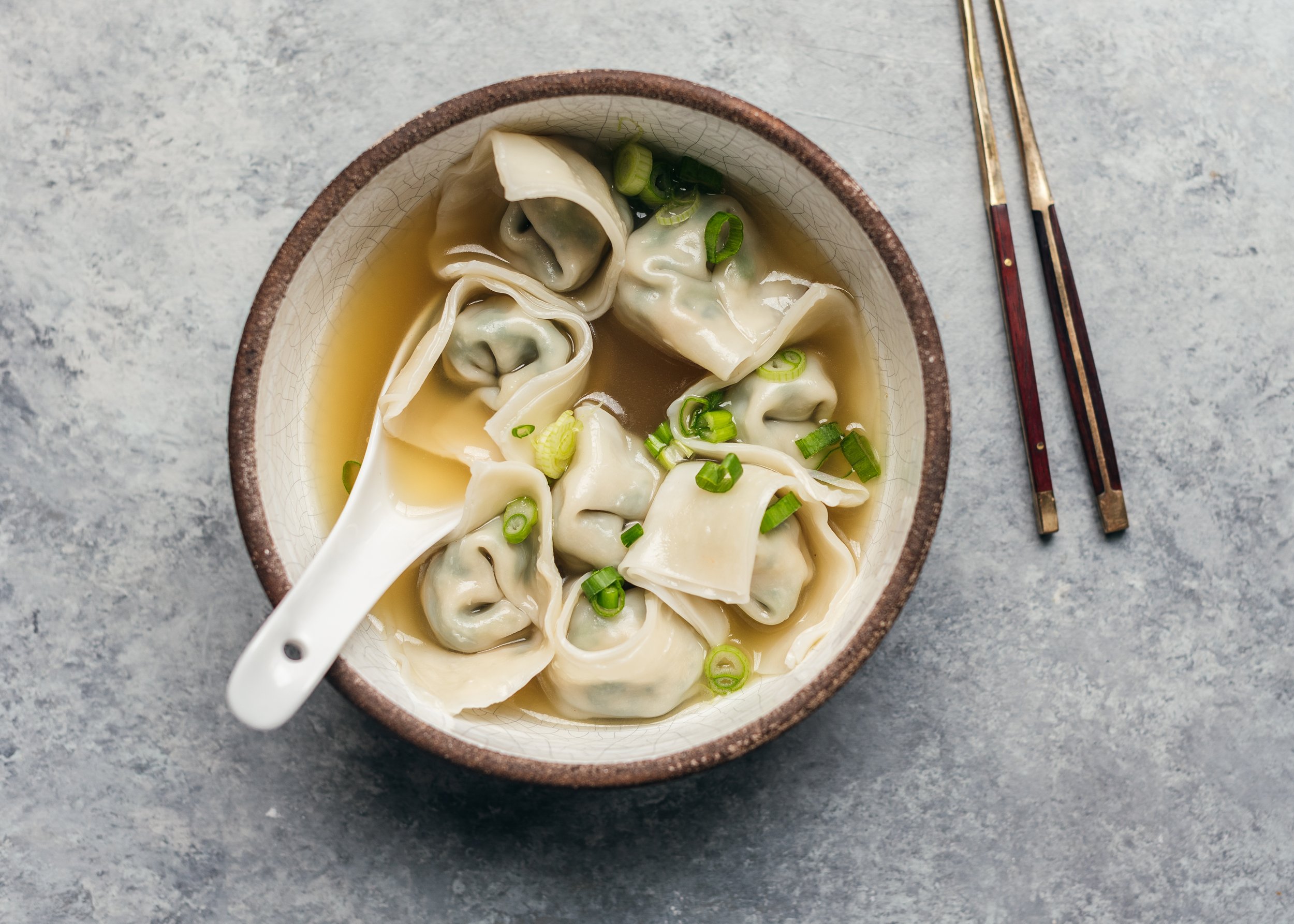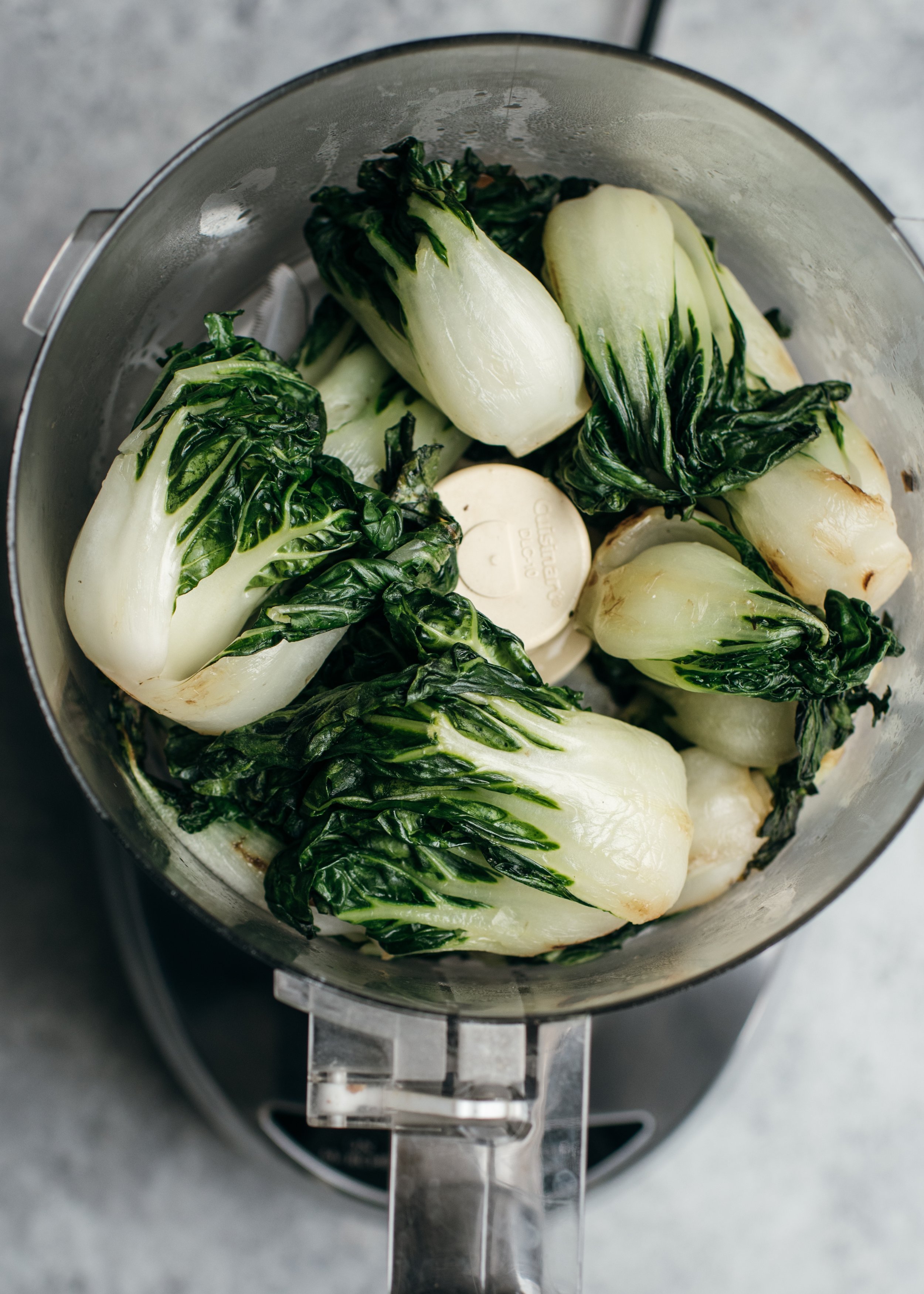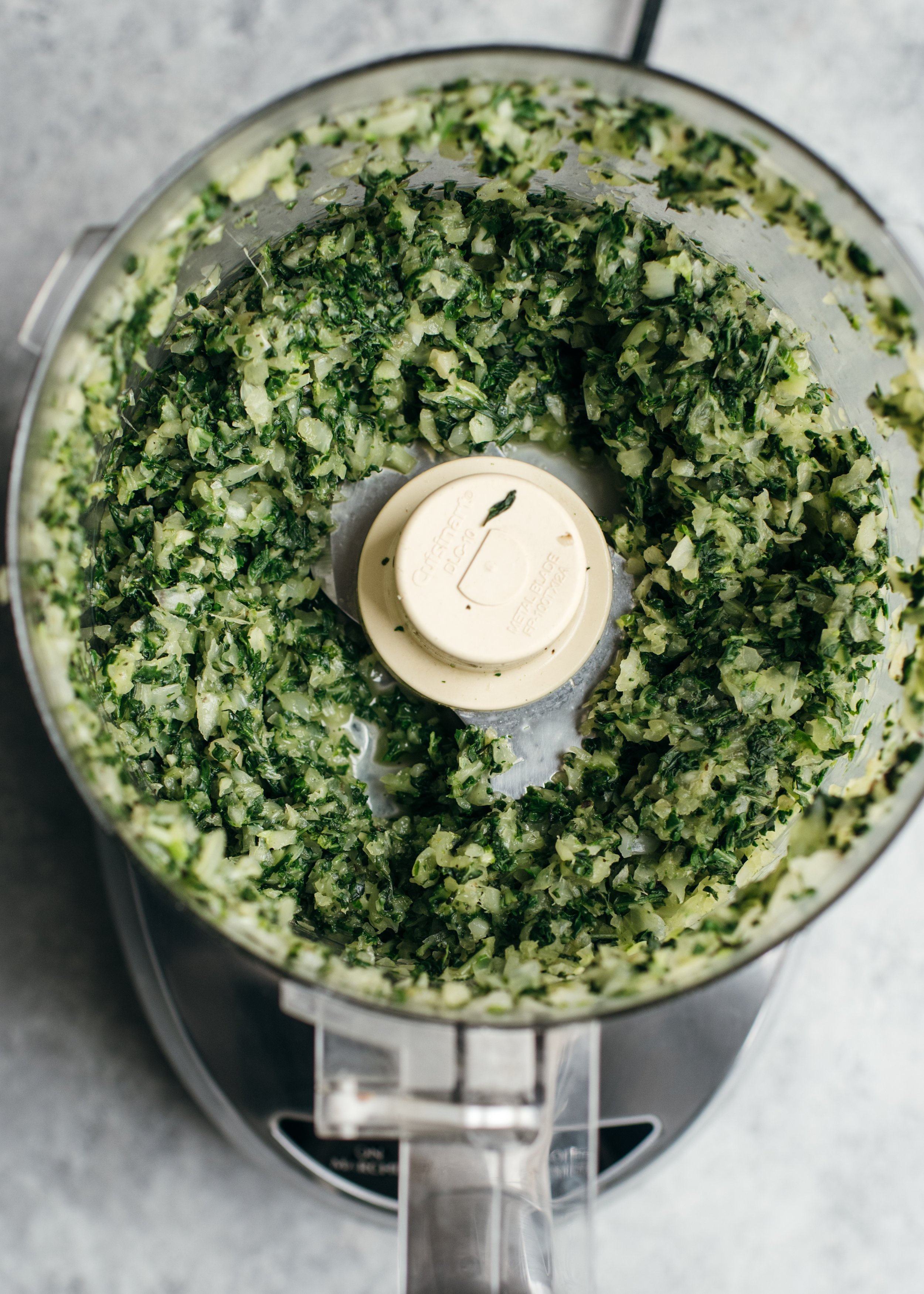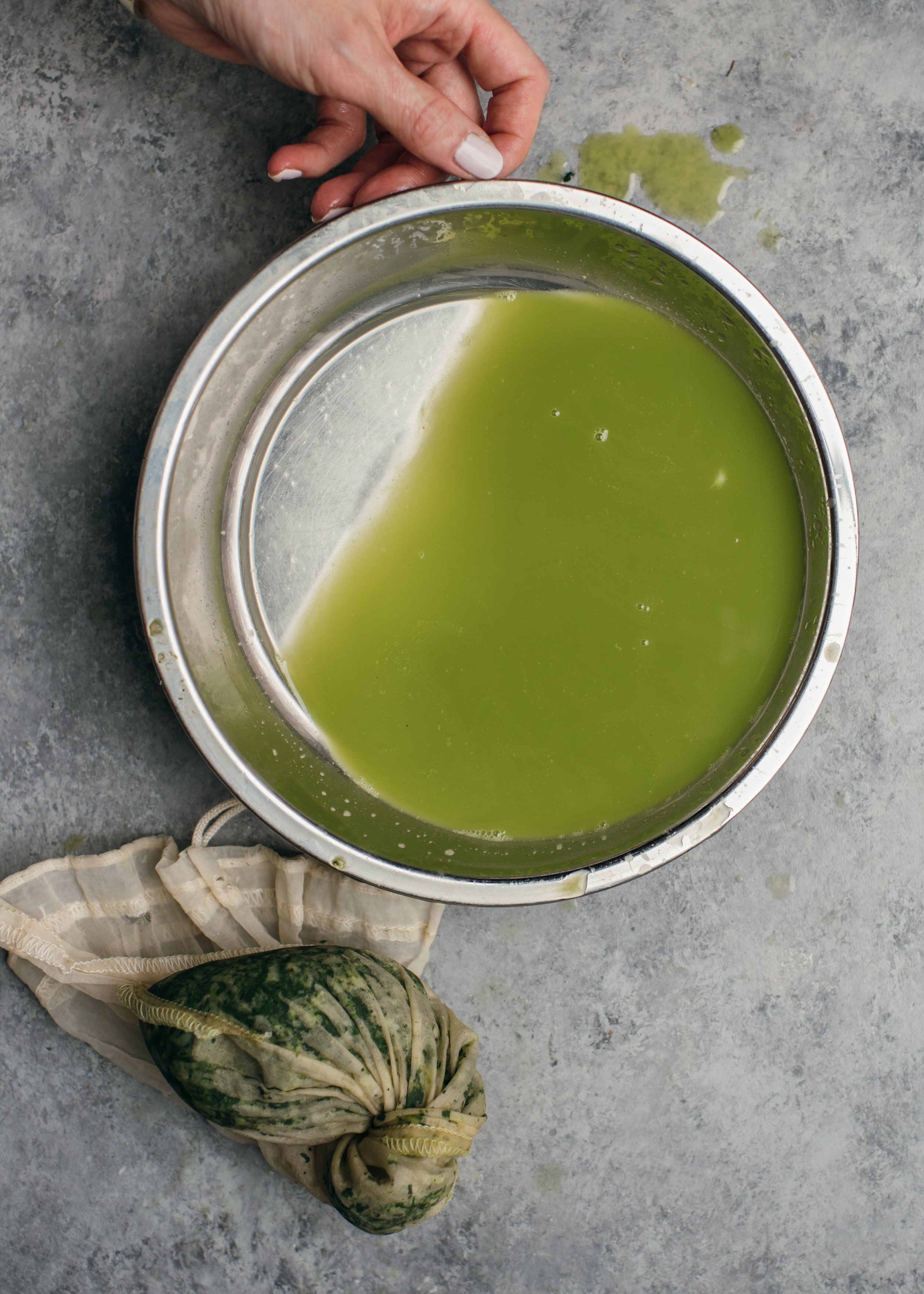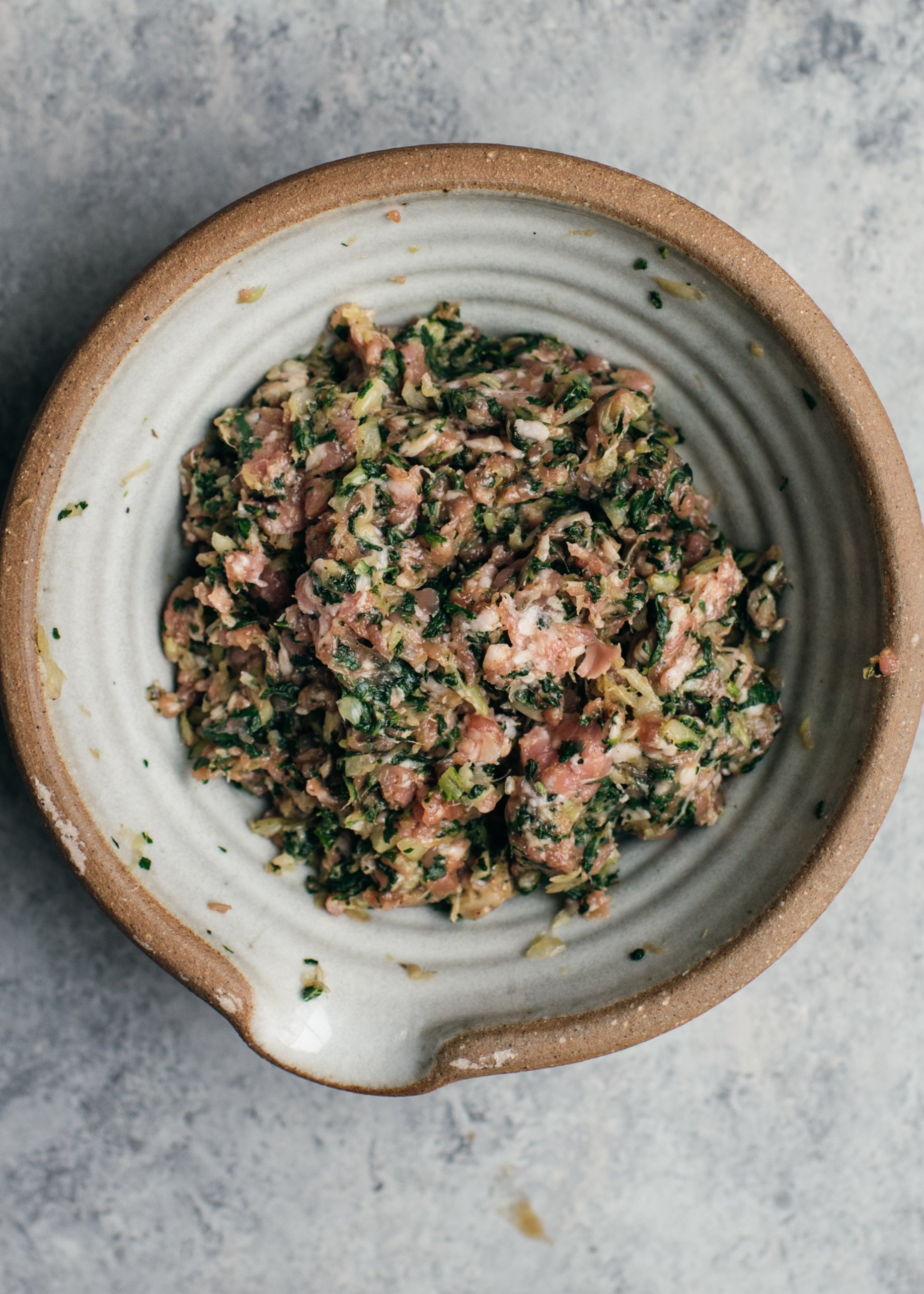Che vey! That's Shanghainese (the dialect spoken in Shanghai, China) for "eat rice" which is like saying "bon appetite" before you begin a meal. These words were most frequently uttered around my grandmother's dinner table. She is credited with this authentic SHANGHAI PORK + BOK CHOY WONTONS / DUMPLINGS recipe and was the one responsible for creating the dumpling-loving monster that I am!
"Wontons" in general can be varied in their fillings, their folded-shape and the wrappers themselves, depending on the region of China from whence they originated. Specifically, SHANGHAI PORK + BOK CHOY WONTONS / DUMPLINGS are filled with ground pork & bok choy and are folded using square-shaped wrappers. You can also substitute ground chicken in place of the ground pork. The term “dumpling” is broader to include the ones folded using round wrappers. Their dough tends to be slightly thicker than the square wonton dough, for a slightly different mouth-feel when you eat them. Round wrappers can simply be folded into half moons or pleated into fancier shapes such as these. My sister and I spent countless hours during our childhood pleating such dumplings, often to the soundtracks of Phantom of the Opera or Mikado, my mom’s favourite musicals.
Sometimes when we are feeling decadent (read: not lazy), we also tuck a tiny morsel of raw white shrimp in with the filling. Shrimp was always present in my grandma’s. She was not lazy. The bok choy in the filling is what makes the preparation a little more involved because it is a watery vegetable that releases a lot of liquid when cooed. It is ESSENTIAL to squeeze a lot of the liquid out of the blanched bok choy greens before mixing with the meat and seasonings for the filling. In my opinion, this step is a definite differentiator between perfect Shanghai dumplings and the often mediocre store-bought or restaurant ones. If the liquid is not adequately squeezed out, the filling is loose and doesn’t have that proper firmness that is crucial for the overall ideal mouth-feel.
We adore eating these SHANGHAI PORK + BOK CHOY WONTONS / DUMPLINGS simply boiled until cooked through and served in a light chicken broth for a cozy meal. Sometimes we’ll drain a batch of boiled ones and pan-fry too for the best of both worlds. We enjoy them with chilli oil or Worcestershire sauce for the panfried ones! Homemade dumplings are a labor of love but SO worth it. Put on some great music or podcast and make asap.
Che vey!
Sonia x
Photo and Video Tutorials
🎥 watch my video tutorials — How to fold dumplings (2 ways - square and round wrappers):
photo tutorial — HOW TO FOLD WONTONS WITH SQUARE WRAPPERS:
MAKE IN ADVANCE:
Wontons freeze well for up to a month. To do so, lay them in a single layer, not touching on a floured or parchment-lined sheetpan. Freeze them this way for at least a couple of hours or until they are quite firm. Once firm, you can toss them into a freezer-safe container or freezer-safe zip top bag with the air squeezed out. To cook from frozen, simply boil them directly from the freezer. Follow the cooking directions in the recipe.
Shanghai Pork + Bok Choy Wontons / Dumplings
Recipe makes 95-100 dumplings. Assuming 13-15 dumplings per person, this should serve 6 adults, maybe with some leftovers to freeze.
INGREDIENTS
For the filling:
1lb (450g) raw ground pork
3lb (1350g) baby bok choy or regular bok choy, washed well (see instructions under method)
2 tbsp tamari or light soy sauce
2 tsp kosher salt (I use Diamond Crystal kosher salt; reduce to 1 tsp if using other brand)
1 1/2 tsp raw cane sugar
2 dashes of white pepper powder
For wrapping:
650g wonton wrappers, 3” square size (about 90-100)
Small dish of tap water for sealing edges
For a super simple dipping sauce:
Equal parts tamari (or light soy sauce) and rice vinegar, plus chili oil to taste.
Optional for serving:
2-3C chicken stock, preferably homemade or store-bought low sodium
Thinly sliced scallions to garnish
METHOD
PREPARE FILLING: (note: you can do this 1-2 days in advance and keep it tightly-sealed in the fridge. I prefer to break up the work this way)
If using regular-sized bok choy, trim ends to separate the stems. I skip this step with baby bok choy. Take care to wash bok choy very well because there is often soil trapped inside the joints where the stems meet. I prefer to wash mine by soaking them 15 minutes in a large sink of water with a generous pour (~3/4 cup) of white vinegar. I always soak leafy veggies in vinegar water but it is optional. (Note: make sure first wash your sink very well with dish detergent since kitchen sinks can harbour a lot of bacteria). Ensure there is enough water in the sink so the bok choys are suspended and not touching the bottom. Soaking this way releases a lot of the soil to the bottom of the sink which we easily discard down the drain. Rinse each bok choy individually under running water ensuring there is no stubborn soil remaining. Drain in large colander.
Preheat large wok or heavy-bottom pot over medium to medium-high heat. Drizzle a tablespoon of neutral high heat oil. In batches, add bok choy and sauté 8-10 minutes or until wilted but not cooked all the way. The purpose of this step is 3-fold: (1) to release some of the liquid (because a wet filling is a no-no for dumplings of any kind), (2) to wilt them so the large volume is easier to handle and are easier to squeeze the liquid out of them in the following steps and (3) removes grassy flavour of raw bok choy.
Drain bok choy in a large colander and allow to cool while you continue with the rest. There may already be liquid draining out. But just wait, there’s gonna be a lot more liquid to remove!
Next, in batches, place bok choy into a food processor. Pulse 10-20 times (depending how large and full your food processor is) to break it down into small pieces. The pieces should be small enough that when combined with ground pork, the filling feels homogenous in your mouth, but don’t puree it into liquid either – please refer to blog post image for ideal size. Alternatively, you can hand chop with a knife.
Once again working in batches, place finely-chopped bok choy into a nutmilk or cheesecloth bag (or wrap securely inside a large doubled-up sheet of cheese cloth or kitchen towel). Squeeze as much of the liquid out as possible. This is a CRUCIAL step otherwise your filling will be too wet. If you don't have cheesecloth or bag, press bok choy against the edges of the colander to squeeze out the liquid, aiming to get 80-85% of the liquid out. As you can see in the blog post images, there is a LOT of liquid in the sautéed bok choy. You’ll likely squeeze out ¾-1 cup of liquid per (raw) pound of bok choy. (You can drink this like a green juice, especially if using organic bok choy J)
Add the well-squeezed bok choy into a large mixing bowl along with the ground pork, salt, tamari (or light soy sauce), sugar and white pepper powder. Mix well. I use my hand for this.
This next step, my dad swears by: using a slim wooden spoon or spatula or two pairs of chopsticks held in a bunch together (my dad and grandma's old school way), mix the meat and bok choy filling with ~vigour~ for 5 minutes or until your arm falls off. This step is to tenderize the meat and pull everything together to form a tighter, more "glue-y" (original culinary term) filling which has a nicer mouthfeel when you bite into a dumpling. The filling is done!
WRAPPING WONTONS: (see step-by-step tutorial above OR my IG how-to video)
Fill each wonton wrapper with a heaped 1 tsp (or 1.5 tsp) of the filling, which is 8-9g. Resist the tendency to overfill. The ratio of filling-to-dough affects the overall mouth-feel. Furthermore, an overstuffed wonton is sure to explode as soon as it hits the boiling water during cooking. If you’re using larger wonton wrappers (more than 3” square), place more filling while maintaining the approximate ratio as you see in the blog post images.
STEPS 1-6 CORRESPOND TO STEP-BY-STEP PHOTO TUTORIAL ABOVE:
(1) Place the filling in the center of the wonton wrapper (2) Fold halfway up, and very gently squeeze around the filling to secure it (3) Curl the wrapper horizontally halfway and (4) begin pulling the lower two corners towards each other (5) Dab a bit of cold water onto the corner parts that will touch (i.e. the bottom of the left corner + top of the right corner) and overlap them (6) Gently squeeze the overlapped corners to stick them together. Voila! One down, 99 more to go. You got this! There are other ways to fold wontons with square wrappers but this is how my family does it.
COOKING WONTONS RIGHT AWAY: To cook the fresh wontons, bring a large pot of water to a boil. Season it with salt the way you would when cooking pasta. Once at a rolling boil, slide the wontons into the pot carefully so as not to scald yourself. Do not overcrowd the pot - you may need to cook in several batches. Boil until the wontons bob up to the top, about 1-2 minutes. Pour about a cup of cold tap water into the pot and wait for it to come to a boil again, about 45 seconds. Drain and scoop out with a long-handled strainer.
FREEZING WONTONS: At this point the wontons can be frozen enjoy another day. Place them in a single layer, not touching, on a baking sheet lined with parchment and put into the freezer for an hour or so. Transfer them into a freezer bag or container. To cook, do not defrost. Place frozen wontons directly into boiling water and follow the same method as Cooking Wontons Right Away (above). It will take a little longer for them to bob to the top. Then add the cup of cold water and re-boil the same way.
OPTIONS FOR SERVING: We enjoy them simply boiled like this, with a dipping sauce (see Dipping Sauce ingredients) or serve the boiled wontons in homemade chicken broth which is the ultimate cozy meal on a wintry night. OR when we haven’t gobbled them up too quickly, we let them stand 10-15 minutes after boiling to dry out slightly, then panfry on a skillet in a bit oil, until golden brown on the edges. I love any and all of these options!
Wontons boiled + served in broth
Wontons boiled, drained well then pan-fried in a skillet with oil. Served with Chinese chili oil


